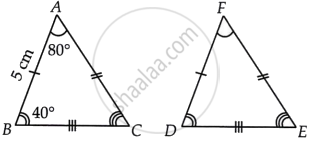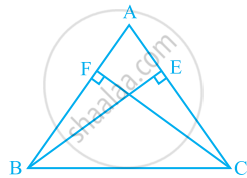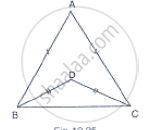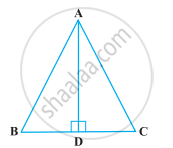Advertisements
Advertisements
प्रश्न
It is given that ∆ABC ≅ ∆FDE and AB = 5 cm, ∠B = 40° and ∠A = 80°. Then which of the following is true?
विकल्प
DF = 5 cm, ∠F = 60°
DF = 5 cm, ∠E = 60°
DE = 5 cm, ∠E = 60°
DE = 5 cm, ∠D = 40°
उत्तर
DF = 5 cm, ∠E = 60°
Explanation:
Given, ∆ABC ≅ ∆FDE and AB = 5 cm, ∠B = 40°, ∠A = 80°
Since, ∆FDE ≅ ∆ABC

∴ DF = AB ...[By CPCT]
DF = 5 cm
And ∠E = ∠C ...[By CPCT]
⇒ ∠E = ∠C = 180° – (∠A + ∠B) ...[By angle sum property of a ∆ABC]
⇒ ∠E = 180° – (80° + 40°)
⇒ ∠E = 60°
APPEARS IN
संबंधित प्रश्न
ABC is an isosceles triangle in which altitudes BE and CF are drawn to equal sides AC and AB respectively (see the given figure). Show that these altitudes are equal.

In figure, AB = AC and DB = DC, find the ratio ∠ABD : ∠ACD

ABC is a triangle and D is the mid-point of BC. The perpendiculars from D to AB and AC are equal. Prove that the triangle is isosceles.
In ΔABC, side AB is produced to D so that BD = BC. If ∠B = 60° and ∠A = 70°, prove that: (i) AD > CD (ii) AD > AC
Is it possible to draw a triangle with sides of length 2 cm, 3 cm and 7 cm?
If the angles A, B and C of ΔABC satisfy the relation B − A = C − B, then find the measure of ∠B.
In the given figure, AB and CD are parallel lines and transversal EF intersects them at Pand Q respectively. If ∠APR = 25°, ∠RQC = 30° and ∠CQF = 65°, then

If ∆PQR ≅ ∆EDF, then is it true to say that PR = EF? Give reason for your answer
M is a point on side BC of a triangle ABC such that AM is the bisector of ∠BAC. Is it true to say that perimeter of the triangle is greater than 2 AM? Give reason for your answer.
ABC is an isosceles triangle with AB = AC and D is a point on BC such that AD ⊥ BC (Figure). To prove that ∠BAD = ∠CAD, a student proceeded as follows:

In ∆ABD and ∆ACD,
AB = AC (Given)
∠B = ∠C (Because AB = AC)
and ∠ADB = ∠ADC
Therefore, ∆ABD ≅ ∆ACD (AAS)
So, ∠BAD = ∠CAD (CPCT)
What is the defect in the above arguments?
[Hint: Recall how ∠B = ∠C is proved when AB = AC].
